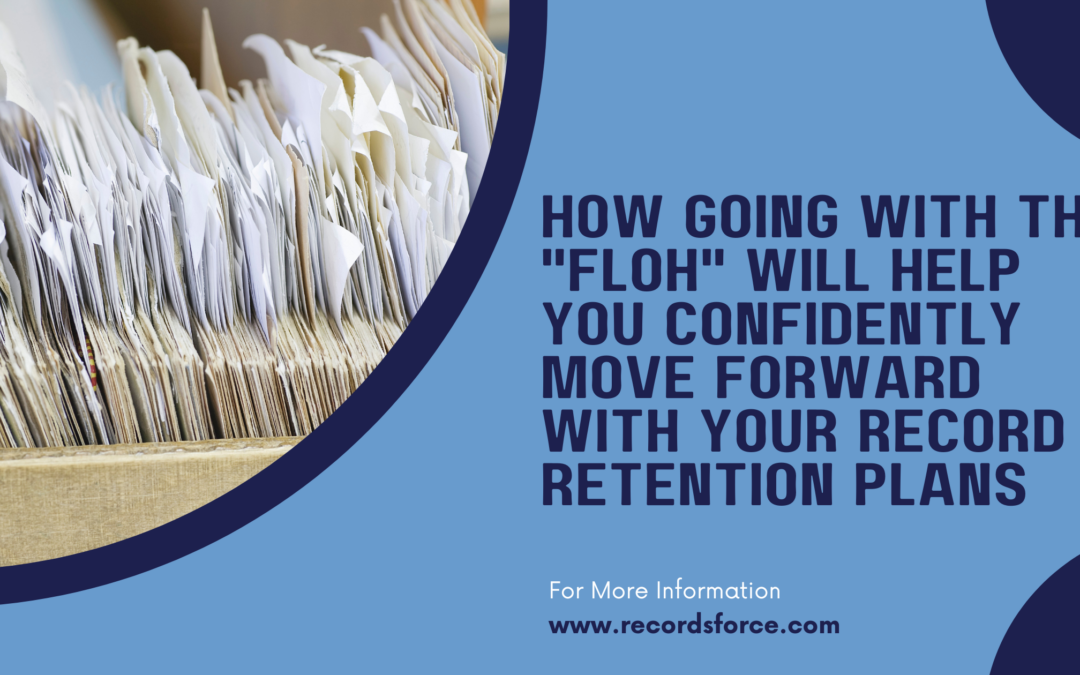Pulling the trigger and approving the destruction of company records always comes with a moment of contemplation. What if I approve the destruction of documents incorrectly? How do we know exactly when the right time to destroy our records is?
Recordsforce has worked with industry experts to create a simple four-pronged test that can quickly enable you to establish record retention policies and a framework to evaluate and defend those decisions. We call it the “FLOH” method.
FLOH stands for Financial, Legal, Operational and Historic. These are the four tests that, once applied to a given document type, will allow the owner of that document to make a clear and rational decision regarding how long to retain it. This system can apply to just about any document type, but for this example let’s start by using inbound vendor invoices as our case in our exploration of the FLOH methodology.
F:
In this case, we first look at the “F” or Financial need to retain a document. Is this type of document needed in order to make a future payment or collect on an outstanding debt? If yes, then we need to keep these documents long enough to pay them and to answer potential questions about how you paid them. In most cases, we would have resolved 99% of issues related to unpaid invoices within two or three years. Based on the “F”, or the Financial part of the FLOH evaluation, we would say three years would be a worst case time frame and two years would support nearly every case.
L:
We all know we keep invoices much longer than two or three years, but why? The “L” in FLOH stands for “Legal” and relates to the need to keep specific documents due to compliance, financial audit or lawsuit involving the retention of invoices. The U.S. Federal Government, via the IRS, has the ability to audit a company’s financial documents, including invoices, for seven years after their creation and requires companies to maintain those financial documents for that period of time.
Why? The invoices are required, as they provide the back-up or evidence that your accounting practices are accurate. That is important to tax collectors like the U.S. government and local and state governments, which all have regulatory authority and requirements. There are many regulating bodies and many different retention implications regarding the “L” requirements in FLOH.
We recommend that you seek the advice of an experienced business attorney from your industry to determine what regulatory agencies your particular company falls under and work to understand and comply with all legal retention requirements. This is the most complicated part of the four tests you apply for retention period determination.
O:
“O” stands for Operational requirements. To determine these requirements, you may ask the question, “How long is this document needed for the company to perform its operational duties?” In the case of an invoice, just long enough to pay it.
If vendors didn’t insist on being paid in order to continue to send goods, you could say you don’t need invoices at all from an operational perspective. That said, companies are beginning to treat invoices as a source of big data to better understand the distribution of the cost of goods across multiple markets. For instance, grocery chains may want to understand where they are getting the best deal for tomatoes out of all of their local farms. By analyzing the invoices from all of their stores, they could make that determination and move purchasing to the farms providing the best deals.
A better example of long term retention of company documents for operational purposes would be if your company built the elevator for the Empire State Building. The plans that were used to make that elevator would still be needed for operational purposes until it was replaced.
H:
Lastly, we come to “H”, which stands for “Historic”. A company may determine that specific documents are important due to their historic significance. For instance, the first invoice ever paid, the first check ever received, the first contract signed or the first drawing created. Because they are significant to the company’s history, they are kept forever. Documents detailing famous people, like famous students at a school or writings by a person who has become famous might all be deemed important historically and kept longer than any other retention test requires.
When combining the four tests, we have a comprehensive way in which any document can be evaluated for retention purposes. This test has been in use for decades and has served the document management clients at Recordsforce very effectively during that period. So well in fact, that perhaps this humble blog will be kept forever, due to its “H”istoric significance!
Go with the FLOH and find your document retention answers! Need help? Call Recordsforce today to discuss your records management needs!

